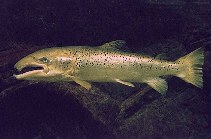| Family: |
Salmonidae (Salmonids), subfamily: Salmoninae |
| Max. size: |
150 cm TL (male/unsexed); 120 cm TL (female); max.weight: 47 kg; max. reported age: 13 years |
| Environment: |
benthopelagic; freshwater; brackish; marine; depth range 0 - 210 m, anadromous |
| Distribution: |
North Atlantic Ocean: temperate and arctic zones in northern hemisphere (Ref. 51442).
Western Atlantic: Atlantic drainages from northern Quebec, Canada, to Connecticut and New York, USA; inland to Lake Ontario where it is now extirpated (Ref. 86798). Landlocked stocks are present in North America (Ref. 1998). Eastern Atlantic: White and Barents Sea basins through northeastern Europe to the Baltic and North Sea basins, including Iceland (Ref. 59043). Introduced to New Zealand, Chile, southern Argentina (Ref. 59043) and Australia (Ref. 6390). |
| Diagnosis: |
Dorsal spines (total): 3-4; Dorsal soft rays (total): 9-15; Anal spines: 3-4; Anal soft rays: 7-11; Vertebrae: 58-61. Distinguished from congeners by having the following unique characters: 10-13 scales between end of adipose base and lateral line; 17-24 gill rakers (Ref. 59043); caudal fin deeply forked in individuals smaller than 20 cm SL; hyaline or grey adipose margin; posterior part of vomer toothless (Ref. 59043). Mouth extends only to area below rear of eye and has well developed teeth (Ref. 51442). Vomerine teeth weak (Ref. 7251). Caudal fin with 19 rays (Ref. 2196). Little scales (Ref. 51442). Juveniles have 8-12 blue-violet spots on the flanks with little red spots in-between (Ref. 51442). Adults at sea are bluish-green dorsally becoming silvery along the sides and white ventrally; with a few black spots but none under lateral line (Ref. 37032, Ref. 51442). Caudal fin usually unspotted and adipose fin not black bordered. During reproduction individuals lose the silvery shine and become dull brown or yellowish. Males may be mottled with red or have large black patches (Refs. 37032, 51442, 88171). Skin becomes thick and leathery. Survivors lose their spawning coloration and are generally dark in colour (Ref. 84357). During the spawning season, males are characterized by elongated hooked jaws that meet at the tips, thicker fins, and slime covering their body. Hook of males dwindle after spawning (Ref. 35388). |
| Biology: |
Amphihaline species, spending most of its life in freshwater (Ref. 51442). Occurs in lakes and rocky runs and pools of small to large rivers (Ref. 86798). Some landlocked populations exist. Found in all rivers where temperature rises above 10° C for about 3 months per year and does not exceed 20° C for more than a few weeks in summer (Ref. 59043) (preferred temperatures 4-12°C). Juveniles may live in cold lakes in northern Europe (Ref. 59043). Parr (i.e. juveniles) are territorial and are found in the upper reaches of rivers and streams, in riffle areas with strong current and rough gravel bottoms (Ref. 7471). During winter, parr seek refuge in small spaces or under stones during the day (Refs. 59043, 89461). Young remain in freshwater for 1 to 6 years, then migrate to coastal marine waters or even to open oceans where they remain for 1 to 4 years before returning to freshwater for spawning (Ref. 51442). Adults inhabit cooler waters with strong to moderate flow (Ref. 44894). The Atlantic salmon is reported to live up to 10 years, but most individuals only reach 4-6 years (Ref. 88187). Juveniles feed mainly on aquatic insects, mollusks, crustaceans and fish; adults at sea feed on squids, shrimps, and fish (Ref. 51442). Most populations depend mostly or exclusively on stocking due to degradations of environmental conditions. Fishing pressure on wild stocks has decreased due to intensive farming but other problems have increased. Farmed salmons escape in large numbers and move to any river and hybridize with wild stocks (Ref. 59043). This species may hybridize with trout (Salmo trutta) (Ref. 59043). Diseases of the species include furunculosis (Aeromonas salmonicida), corynebacterial kidney disease (Renibacterium salmoninarum), enteric red mouth disease (Yersinia ruckeri), infectious pancreatic necrosis virus, bacterial kidney disease, fin rot and fungus infections (Ref. 5951). Marketed fresh, dried or salted, smoked, and frozen; eaten steamed, fried, broiled, cooked in microwave, and baked (Ref. 9988). |
| IUCN Red List Status: |
Near Threatened (NT) (A2bd) Ref. (130435)
|
| Threat to humans: |
harmless |
Source and more info: www.fishbase.org. For personal, classroom, and other internal use only. Not for publication.

